I bought some single strand wires hoping to prototype on the breadboards. Unfortunately it was too small to properly fit into the breadboard holes.
So my question is which gauge fits well on those small holes of breadboard?
I bought some single strand wires hoping to prototype on the breadboards. Unfortunately it was too small to properly fit into the breadboard holes.
So my question is which gauge fits well on those small holes of breadboard?
Plain single stranded copper wire works fine in these breadboards. That's what I primarily use. I find 22 guage is about right.
Fancy specially made jumper wires may be more reliable in the long run, but cutting a piece of wire off a roll and stripping the ends is easy and quick. You can do that many times for the cost of one jumper wire.
A while ago I bought a set of pre-cut and pre-stripped wires for this use from Jameco. It sounded like a good idea at the time. Having the wires ready to use is nice, but they stupidly decided to bend the stripped ends at right angles right where the insulation ends. That makes them difficult to use except for the ones that only go 1, 2, or 3 holes. As I cut and strip more jumper wires from a 500 foot roll of #22 wire, I put them into the box the Jameco kit came in according to their lengths. Over the years, the stripped ends of a few wires have broken right at the end of the insulation. This happens quite rarely, so the trouble to cut and strip a new wire is nothing.
AWG22 or AWG24 generally work well. i personally prefer AWG24. Anything bigger than AWG22 can mangle the breadboard connector (I've had to unmangle some). Anything smaller than AWG24 may not connect reliably.
When you cut the wires, cut on an angle, not straight across the wire. This gives you a needle point on one side, and makes insertion easier. (Hypodermic needles are constructed this way for precisely this reason.)
Although both 22 AWG and 24 AWG solid-core wire works well, my preference is to use 24 AWG.
There are several reasons but the main reason is so that the contacts in the breadboard don't stretch or otherwise become deformed.
You won't notice the stretched contacts until you go to use a component with small diameter leads. 1N4148 diodes are where I notice stretched contacts - the diode lead just isn't tight in the contact.
I make my own breadboard jumper wires from standard 24 AWG telephone wire. Your friendly telephone installer is usually happy to hand out 25-pair off-cuts anywhere from several feet long to as much as you can carry.
Don't strip the jacket from the cable until you have cut it into the desired lengths. That gives you 50 pieces of that length.
After I have stripped the insulation from the individual wires, I use a pair of scissor-type wire strippers (Miller 101) to cut the very tip of the stripped wire at an angle. That makes inserting the wire into the breadboard very easy.
RadioShack sells a jumper wire kit for use with their solderless breadboard. I'm not recommending that to you, since you are outside of the U.S., but using that as an example -- the wires are 22-gauge.

0.6mm diameter single/solid core wire works great for breadboards. This is the same as the diameter of a typical 1/4W resistor lead. In AWG terms, 0.6mm is between 22 AWG and 23 AWG.
Using just plain wires is never an optimal solution. Breadboards require that you push in some solid copper, but solid copper wire is difficult to route. You should just buy a set of Jumper Wires, like this:
http://www.pololu.com/catalog/category/68
And I think you can probably get them for less.